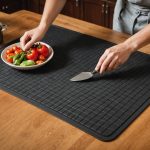Understanding the Link Between Kitchen Layout and Eating Habits
In recognizing the connection between kitchen design impact and eating behavior, research reveals that the physical layout of a kitchen can subtly influence our dietary choices. A well-organized and thoughtfully designed space can encourage healthier eating by making nutritious options more accessible and appealing.
Psychological Factors and Optimized Kitchen Spaces
Psychological factors play a significant role in how food choices are made. For example, arranging food storage to keep healthier items at eye level or within easy reach can make it more likely for individuals to opt for these when preparing meals. The aesthetics of a space, such as lighting and colour schemes, can also affect mood and, consequently, food preferences, promoting a positive association with healthy eating.
In parallel : Revamp Your Diet: How a Kitchen Chalkboard Wall Can Streamline Your Meal Planning and Achieve Dietary Goals
Research Findings on Healthier Eating Spaces
Studies have shown that certain kitchen layouts, like those with open shelving, provide visibility of healthy options, effectively reinforcing healthier eating patterns. Such spaces remove visual barriers, constantly reminding individuals of their food choices. The presence of dedicated prep zones within the kitchen further maximizes space efficiency and supports consistent meal preparation of balanced and nutritious meals.
Principles of Effective Kitchen Layout for Healthy Eating
Creating a kitchen that encourages healthy eating involves purposeful kitchen design principles. A functional kitchen is strategically organized to simplify meal preparation and enhance dietary choices. Small adjustments can significantly influence how accessible and appealing healthy options are.
Additional reading : Effortless Meal Planning: The Definitive Guide to a Streamlined Kitchen for Diet Success
Maximizing Space Utilization
Optimizing every inch of your kitchen is vital, especially in limited spaces. Start by implementing clever storage solutions like pull-out shelves and vertical racks. Such innovations not only help keep your kitchen organized but also make healthier items prominent. Decluttering your kitchen prevents distractions, maintaining focus on cooking nutritious meals.
Creating Functional Zones
Designating distinct areas for cooking, prepping, and snacking enhances workflow and reduces confusion. Establishing a dedicated meal prep station can streamline cooking processes, fostering efficiency and reducing temptation to reach for unhealthy snacks. Proper space management between cooking and eating zones fosters a logical movement pattern, encouraging mindful snack choices.
Enhancing Accessibility and Visibility
Positioning healthy foods at eye level and within easy reach emphasizes their importance, encouraging healthy eating design. Visual cues, such as using clear storage containers, make nutritious choices more enticing. Conversely, store tempting snacks out of sight to decrease their allure, encouraging better eating behaviours within a functional kitchen.
Practical Design Tips for Redesigning Your Kitchen
Transforming your kitchen into a hub for healthy living is more accessible than you might think. By leveraging simple kitchen redesign tips, you can enhance space management and promote healthier habits. Start with open shelving; it not only modernizes your kitchen but also improves visibility of healthy foods, keeping them top of mind. Clear storage solutions further this idea, offering easy access while maintaining order.
Consider the impact of colour and lighting. A vibrant cooking atmosphere can stimulate excitement about food preparation. Use warm tones to create a welcoming environment; ensure good lighting around work areas to avoid shadows, making every corner functional.
Effective appliance placement is key. Group your most-used cooking appliances close together to form a cohesive workflow, reducing the time and effort between steps. Integrating dedicated zones for various tasks prevents clutter and chaos, promoting efficiency.
Lastly, remember that redesign should suit your lifestyle. Choose elements that resonate personally, ensuring your kitchen is both functional and enjoyable. Prioritize elements that encourage healthy habits while maintaining your unique style. Through thoughtful redesign, your kitchen becomes not just a place for cooking, but a partner in your wellness journey.
Case Studies of Successful Kitchen Transformations
Exploring kitchen makeover examples can inspire individuals seeking to enhance their culinary spaces. These examples of successful redesigns showcase the profound impact a carefully designed kitchen can have on lifestyle and eating habits.
Case Study: Small Space Optimization
In a remarkable transformation, a compact kitchen was reimagined into a functional cooking area. Key design elements such as vertical storage solutions and multi-purpose countertops played pivotal roles. These innovations not only maximized space management but also offered greater efficiency during meal preparation. The results were improved organization and accessibility, significantly influencing the family’s eating habits. Post-redesign, the family reported an increase in home-cooked meals, directly tied to the kitchen’s enhanced functionality.
Case Study: Open Concept Kitchen
An analysis of an open kitchen redesign highlights its success in promoting social cooking. This layout fostered family engagement during meal preparation and eating, enhancing overall meal experiences. The open design improved visibility of healthy ingredients, making them more appealing and thus encouraging healthier choices. The combination of a welcoming atmosphere and convenient accessibility turned meal times into shared, pleasurable activities.
Case Study: Transitioning to Dedicated Cooking Spaces
When kitchens are redesigned with clear, dedicated zones for cooking, significant impacts on meal preparation and consumption behaviors emerge. These spaces promote organized and efficient cooking processes, leading to healthier eating patterns. Long-term benefits include a sustained increase in nutritious food consumption and an overall improvement in daily dietary habits, exemplifying space management success.



